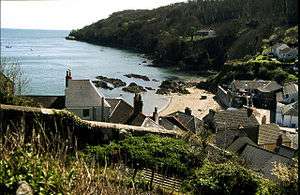Attack on Cawsand
The Attack on Cawsand was a minor Spanish raid on the coast of Cornwall, England, on the night of 14 March 1596 during the Anglo-Spanish War.[5]
In August 1595 the area of Mount's Bay in Cornwall had been attacked by a Spanish raiding force led by Carlos de Amésquita. In that attack over two days, Penzance, Newlyn, Mousehole, and Paul were raided and torched.[6]
In March 1596 a Spanish pinnace arrived in Cawsand Bay just below Mount Edgcumbe with upwards of 25 men armed with muskets. The Spanish managed to land on the beach and made their way to the village. They fixed barrels of gunpowder and brimstone to the doors of several houses and to two boats in the harbour, setting them on fire.[1][4] The Spanish were spotted by one member of the militia who had gone ahead of the main force; he promptly opened fire with a caliver, scaring the intruders off. Shortly after, the main militia force arrived in the village from Plymouth in time to prevent the fire from spreading to the whole settlement.[1][2]
The defences were strengthened as it was feared that the Spanish would try again. The heights were then manned by 170 pikemen, 300 musketeers and cavalry commanded by Sir Nicholas Parker and maintained by sole expense of Richard Carew.[7]
The Spanish would try much larger descents on the British isles; an attempt in October the same year known as the 2nd Spanish Armada failed due to storms.[8] The following year an attempted landing also failed after a storm in the English channel dispersed the fleet and a number of ships were captured.[9]
A second naval raid on the area took place on 26 April 1599, when four Spanish warships captured five fishing boats from Plymouth Sound.[3][4][10][11]
Years later, when the Mayflower's Pilgrims had a port of call at Cawsand, they recalled the Spanish burning of the village, and how they spared the brick walls by the beach.[12]
See also
Citations
- Harrison p. 82.
- Longmate p. 488.
- Carew, Richard (1953). The survey of Cornwall. Melrose. p. 37.
- Annual Reports and Transactions, Volume 6. Plymouth Institution and Devon and Cornwall Natural History Society. 1887. p. 313.
- Daniell, John (1880). A Compendium of the History of Cornwall. Netherton & Worth. p. 156.
- Publications of the Navy Records Society, Volume 22. Navy Records Society. 1902. p. 323.
- Carrington, Henry Edmund (1828). The Plymouth and Devonport Guide: with Sketches of the Surrounding Scenery. Byers. p. 87.
- Leathes, Stanley. The Cambridge Modern History, Volume 3. CUP Archive. p. 529.
- Schomberg, Isaac (1802). Naval Chronology, Or an Historical Summary of Naval and Maritime Events from the Time of the Romans, to the Treaty of Peace 1802: With an Appendix, Volume 1. pp. 32–33.
- Rowse, A. L. (1987). Court & Country: Studies in Tudor Social History. Harvester Press. p. 265. ISBN 0710811470.
- Worth, Richard Nicholls (1890). History of Plymouth: From the Earliest Period to the Present Time. W. Brenden. p. 59.
- Bunker, Nick (2010). Making Haste from Babylon: The Mayflower Pilgrims and Their World: A New History. Knopf Doubleday Publishing Group. p. 33. ISBN 978-0-307-59300-9.
- Bibliography
- Longmate, Norman (2011). Defending The Island: From Caesar to the Armada. Random House. ISBN 9781446475751.
- Harrison, G.B (2013). A Second Elizabethan Journal Volume 2 of Elizabethan and Jacobean journals, 1591-1610. Routledge. ISBN 9781136355578.
